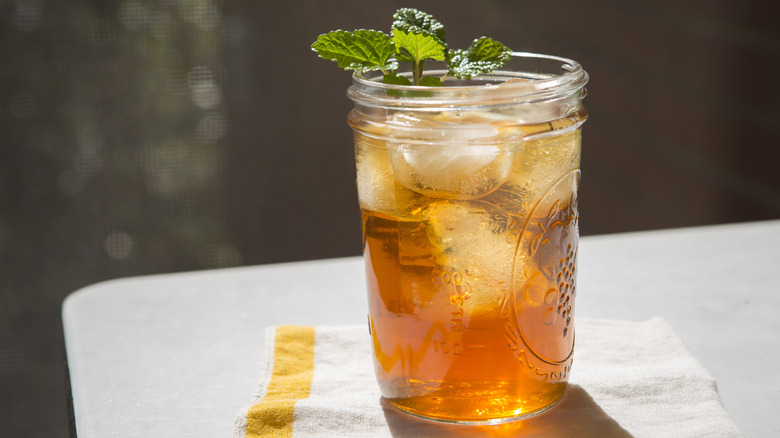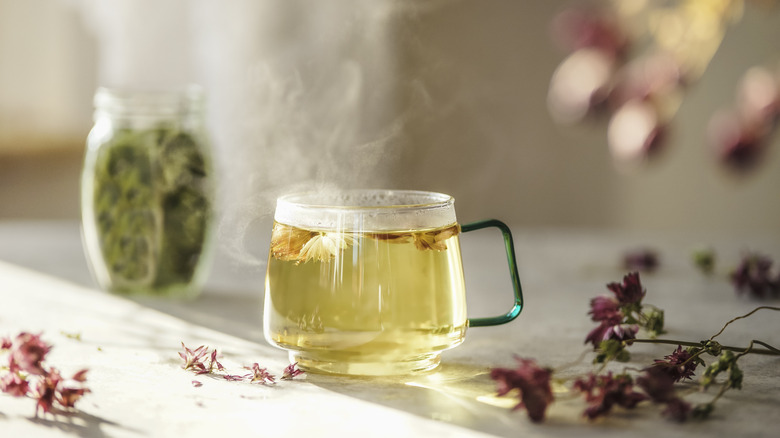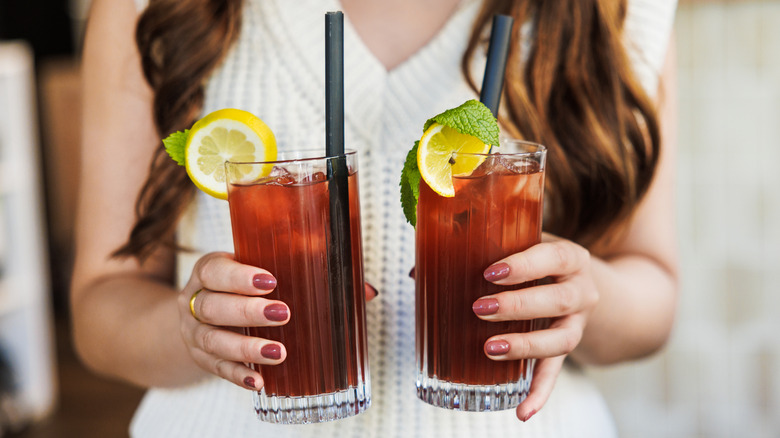Water Temperature Matters When Brewing Different Kinds Of Iced Tea
When iced tea is made right, it's a deliciously refreshing drink that's perfect on a hot, sunny afternoon and great for keeping in the fridge. It doesn't matter whether you like green or black tea or even any of the myriad of flavored teas. When done wrong, though, it can come out weak or — even worse — bitter. This may be the case if you subscribe to the idea that hot-brewed iced tea is far superior to cold-brewed.
Fortunately, the best iced tea recipes are simple, and you only have to pay attention to the water temperature. It makes a big difference in the flavor, and it's not a one-size-fits-all kind of situation — it's about matching the water temperature to the type of tea.
Here's a good way to think about temperature and type: Black tea is generally a stronger, bolder tea, so it can hold up to hot water. The more delicate flavors of green tea need a daintier touch and cooler water, which makes sense, right? If you have a terrible time remembering exact temperatures, here's a general sort of rule: Water should be at a full boil for black tea, and for light and green teas, your water is perfect when you're just starting to see those first bubbles.
Temperatures that are best for hot-brewed iced tea
Now, let's talk about temperatures. The ideal range for brewing black tea that you'll turn into iced tea is between 208 and 212 degrees Fahrenheit (which also applies to most herbal teas). As for white and green tea, you'll want to brew them between 170 and 185 degrees Fahrenheit. But why?
Tea gets its flavor from the extraction of tannins in the leaves, and depending on the type of tea, that happens at different temperatures. Water that's not the proper temp will over- or under-extract the tannins, and that means getting a tea that's not in that sweet spot.
There's actually a term for when water that's too hot for the tea leaves is used, and that's called burning the tea. Too-hot water means you're over-extracting the tannins, and that's where that unpleasant bitterness can come from. A similar problem happens when you leave the tea in the water for too long. The sweet spot (which is usually specified on the package) is between three and five minutes, and if you let it sit longer, it'll end up being bitter. If you want your tea to be a little stronger than usual, you can absolutely and easily make that happen: Add another tea bag, but keep the water temperature and the steeping time the same.
Other things to keep in mind when prepping water for iced tea
If you're making an iced white tea with pear, you'll aim for cooler water, but tradition says to boil the water first, then let it cool down to your desired temperature. It's an ancient idea called kai shui — which means to "open the water." It has some practical benefits in our modern tea-making world. Boiling the water first can help get rid of any funky chemical tastes and odors that might be in your water, which brings us to another thing that you'll want to keep in mind.
Using regular tap water will also do your tea a vast injustice. Filtering the water will get rid of a lot of the chemicals that can change or even mask the flavor of the tea, and those flavors are what make tea so downright delightful in the first place. Also? When you're making iced tea, filter the water for the ice cubes, too. If you're really serious, you might even want to opt for bottled water.
Water quality makes a huge difference when it comes to tea. If you find yourself with a free afternoon, do a bit of a fun science project by brewing tea in a number of different ways and then taste-testing them side-by-side to experience the differences yourself.


